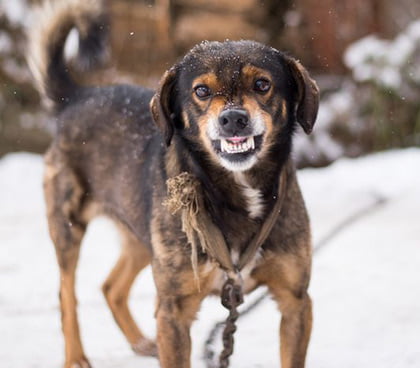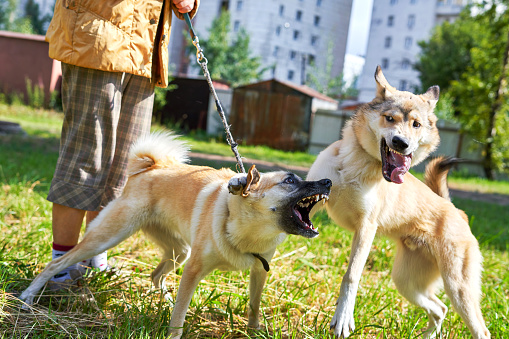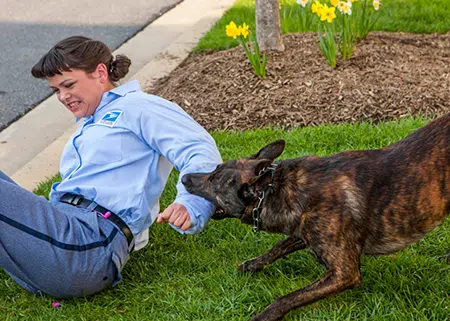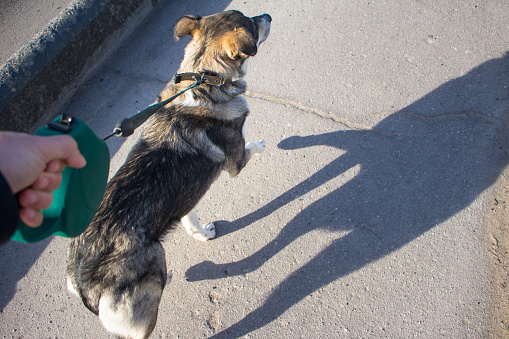
We like to think of dogs as happy-go-lucky creatures who are always friendly and (mostly) well-behaved. However, dogs can be aggressive when they want—or are induced—to be, for a wide range of reasons.
While it is normal for a dog to show aggression under certain circumstances, aggression should never be encouraged. An aggressive dog can be a threat to other animals and to people.
We advocate strongly on behalf of injured victims of dog bites across Ohio, with convenient locations in Akron, Canton, Cincinnati, Cleveland, Columbus, and Toledo.
There are many causes of aggression in dogs.
Illness or Injury
Illness and injury are among the most common causes of canine aggression. If your otherwise well-behaved dog suddenly shows signs of aggression, the dog could be ill or injured. If there is no other explanation for your dog’s aggression, take the dog to your vet as soon as possible for a thorough examination.
Fear
If your dog is afraid of another animal or a person, it might become aggressive as a defense against the perceived threat—especially if the dog is backed into a corner and senses that it cannot retreat or escape safely.
Possessive Behavior
Some dogs are extremely possessive of their food, bones, chew toys, and other items that belong to them. They don’t like to be disturbed while eating or playing with their toys—especially by strangers. Growling and barking when someone gets too close to the dog’s food bowl or toys are typical signs of possessive behavior.
Protective Behavior
By nature, dogs are protective of their territory, their owners, and members of their own pack. They tend to show signs of aggression if they sense that an animal or person is an intruder or a threat.
Dominant Behavior
In the presence of other dogs, your dog might become aggressive to establish its dominance. Your dog might growl, bark, or even snap at any dog who challenges its dominance.
Predatory Behavior
Your dog might be generally sweet and friendly, especially around you and your family. However, a dog is still a carnivore and a predator by nature. If your dog is around smaller animals, its predatory instincts might take over and your dog might chase the other animals.
Frustration
Dogs are highly social. In general, they love being outdoors, and enjoy interacting with people and other animals. If they are caged, chained or tethered most of the time, dogs tend to feel trapped and frustrated. These feelings can cause dogs to become aggressive.
Mating-Induced Aggression
A male dog does not like to be interrupted by another dog or any person, including its owner, when it is seeking the attention of a potential mate—a female dog. If two or more male dogs are in the presence of an available female, they may become hostile toward each other as a result of mating-induced competition.
Jealousy-Induced Aggression
An overly possessive dog may resent its owner’s interactions with other animals or people. For example, if someone interrupts you while you are playing with your dog, he or she could become a target of your dog’s aggression.
Similarly, your dog may resent a new addition to your family—another pet, or a baby—if the dog ceases to be the center of your attention.
Punishment-Induced Aggression
There is a difference between disciplining your dog and punishing it. The former is essential and improves the dog’s behavior, while the latter can worsen your dog’s behavioral problems.
Routinely screaming at your dog, beating it, or avoiding it completely as a means of punishment can make the dog more anxious, more frustrated, and more aggressive.
Forced Socialization
Even though dogs are friendly and social by nature, they can be choosy about those with whom they bond. Forcing your dog to be near a person or dog whom it dislikes may cause the dog to become aggressive.
Overly Friendly Strangers
If a stranger tries to be too friendly with your dog, by getting too close or trying to hug it, the dog might perceive this as a hostile act and react aggressively.
Lack of Attention from the Owner
It goes without saying that your dog craves your attention. Dogs love their caregivers unconditionally, in a powerful way that cannot be duplicated in humans. Dogs who are ignored by their owners are more likely to become anxious and aggressive than dogs who get sufficient playtime and have a close bond with their owners.
Separation Anxiety
Dogs generally dislike being left alone for long periods, which leads to separation anxiety. This anxiety can cause your dog to become aggressive.
Unwanted Scents
Dogs tend to avoid scents that make them uncomfortable. For example, most dogs hate the smell of ammonia-based cleaning solvents, vinegar, and chili peppers. If your house smells strongly of scents that are unpleasant to your dog, the dog may feel uneasy and act aggressively.
Unhappy Household
Dogs are incredibly sensitive to human behavior and can pick up on emotional cues, as humans do. If you are generally anxious and unhappy, your dog might mirror these feelings. And if your dog is anxious and unhappy, there is no telling how the dog might behave.
Hormones play a role in canine aggression.
A dog’s hormonal levels play a key role in shaping its temperament and behavior. According to a Frontiers in a Psychology study, two hormones—oxytocin and vasopressin—play a significant role in determining a dog’s behavior.
Oxytocin is associated with childbirth and plays a key role in the bonding between a mother and her baby. Vasopressin, on the other hand, is associated with social behavior and is known to stimulate feelings of aggression.
According to the study, even-tempered dogs, such as service dogs, tend to have higher than average levels of oxytocin. Dogs that are aggressive in nature tend to have higher than average levels of vasopressin.
At the same time, a dog’s hormonal function is largely influenced by the dog’s day-to-day activities. When a dog interacts with a person or another animal in a friendly way, its vasopressin levels tend to decline and its oxytocin levels tend to increase. In other words, the more a dog feels loved and appreciated, the less likely it is to become aggressive.
Know the symptoms of canine aggression.
Repeated Yawning
According to animal behaviorists, dogs tend to yawn not only when they are tired, but also when they are upset, stressed, anxious, or agitated. If your dog keeps yawning even though it gets plenty of sleep, this might be a sign of anxiety or aggression.
Licking the Lips
It is perfectly normal for your dog to lick its nose and lips when it is hungry or if there is food or a treat nearby. If your dog licks its nose and lips even when it is not hungry or when there is no food nearby, this could be a sign that your dog is angry.
Lack of Eye Contact
Like people, dogs tend to avoid making eye contact with people at whom they are angry. If your dog is reluctant to look you or anyone else in the eye, the dog may be angry.
Destructive Behavior
One of the ways in which dogs show their aggression is by destroying things—chewing up your shoes, pillows, couch cushions, and anything else that they can get their paws (or teeth) on. If your dog is particularly spiteful, it might pee or defecate inside the house or even in your favorite shoes.
In some cases, urinating and defecating in the house could be a sign that your dog has an anxiety disorder or phobia. If so, disciplining your dog for its behavior might not yield any results. The root cause of your dog’s problem must be addressed first.
Disobedience
Your dog’s refusal to obey your orders may be a sign of aggression. It could mean that something in the immediate environment is bothering your dog, or that the dog is angry at you.
Change in Body Language
If your dog stands still, becomes rigid, and stares at you with wide, alarmed eyes, be careful! This could be a sign that your dog is anxious, angry, or afraid. Take a step back and talk to your dog in a calm and reassuring voice to make the dog feel safe and relaxed. Trying to shout at your dog and attempting to impose your will on the dog may exacerbate the problem.
Growling and Barking
Growling and barking are obvious signs of canine aggression. If your dog growls or barks in a threatening manner, the dog may be angry or feel threatened.
Biting
Biting is the most dangerous sign of canine aggression. If your dog attacks and bites you, another person, or another animal, take the dog to a vet immediately and get it checked.
Try to calm your dog if it exhibits signs of aggression.
If your dog is behaving aggressively, here are some tips for addressing its behavior:
- Leave the dog alone for a few minutes. Make sure no one—young children in particular—disturbs the dog for some time.
- Try to communicate with your dog in a calm and reassuring voice. Do not shout at it or try to force it to obey your commands.
- If there is a particular scent or object in the immediate environment that is bothering your dog, remove it and allow your dog to calm down. Petting it, or scratching its stomach area or belly while talking to it calmly may help.
Talk to a veterinarian.
If your dog has shown signs of aggression, take it to your vet for a thorough examination. If there is no physical injury or illness, other factors—such as anxiety disorder or phobia—may be at play. In that case, the vet may prescribe medication to regulate the levels of neurotransmitters in your dog’s brain to reduce anxiety, aggression, and phobia.
Behavioral modification therapy may help.
Behavioral modification therapy can be vital in treating canine aggression. Seek help from an animal behaviorist or a dog trainer, especially if your dog refuses to obey your commands and acts aggressively.
Professional trainers use techniques like counter conditioning, classical and operant conditioning, desensitization, and response substitution to curb your dog’s aggressive instincts and change its behavior. Most trainers will teach you various techniques that you can use to improve your dog’s behavior.
Remove triggers and stressors.
You must create a safe environment while your dog is undergoing behavioral modification therapy. List all the things, sounds, and scents that trigger your dog’s aggressive behavior, and eliminate them. Triggers, stressors, and other negative stimuli may undo the progress made by the trainer.
If your dog is aggressive toward other animals, avoid dog parks and other places where it may encounter them. If loud noises trigger your dog’s fear or aggression, put an anxiety wrap on the dog to calm it.
Don’t punish your dog.
Punishing an aggressive dog serves no purpose and could be counterproductive. Instead, you must address the root cause of your dog’s behavior.
- Punishing a dog who is exhibiting signs of aggression (stiff and rigid stance, baring its teeth, growling, and barking) can exacerbate the situation, potentially causing the dog to attack you.
- Inflicting severe punishment, especially when your dog is afraid or anxious, can destroy the bond between you and your dog.
Prevent aggressive behavior in your dog.
The best way to avoid aggressive behavior is to begin training your puppy when it’s young (3 to 12 weeks old). Here are some things you can do to help your pup become a well-behaved dog:
- Socialize your puppy with other dogs of different sizes and breeds and with people.
- Expose your puppy to new places, new situations, and new people regularly.
- Take your puppy with you when you go to public places where it can see different kinds of people and hear different sounds.
- If your dog gets aggressive while playing with you, stop immediately and leave the room. After a few minutes, return to the room and resume playing. If the dog does it again, leave the room again. Do this again and again until the dog understands that you won’t play if it behaves aggressively.
- Every time your dog obeys your commands, reward it by offering a treat. Your dog will soon learn that just as bad behavior has unpleasant consequences, good behavior brings rewards.
- Don’t allow your dog to play with aggressive dogs. When it is around aggressive dogs, your dog might feel compelled to adopt an aggressive posture to defend itself.
- Make sure your dog gets plenty of exercise and playtime. One of the causes of pet dogs’ aggression is the lack of any healthy outlet for their pent-up energy. The more active your dog is, the happier it is likely to be.
Proper training, good nutrition, regular exercise, and lots of love are the keys to preventing aggressive behavior in your dog.
If you are bitten by someone else’s dog, trust a full-service law firm to protect your interests.
Dog bites can have serious consequences. As a responsible dog owner, you may hesitate to file a claim against the owner of a dog that has bitten you. Although it’s rare, even the gentlest dog can react to unanticipated stimuli with tragic results. If you’ve been injured by someone else’s dog, you deserve to be compensated, even if the dog that bit you was usually as well-behaved as your own dog. Once your medical issues are under control, reach out to an experienced law firm with expertise in dog bite cases.
Like so many others who have placed their trust in us, you can count on Slater & Zurz LLP to thoroughly evaluate your rights, answer your questions, and recommend the best path forward for you, based on your circumstances and the expertise we’ve developed over the years handling dog-bite cases. Our dog bite lawyers have over 30+ years in dog bite cases. Call our team of seasoned professionals for a free consultation. We’re here to serve your legal needs with compassion, dedication, and the drive to win.





